Cossack Thermopylae: the Battle of Cupid
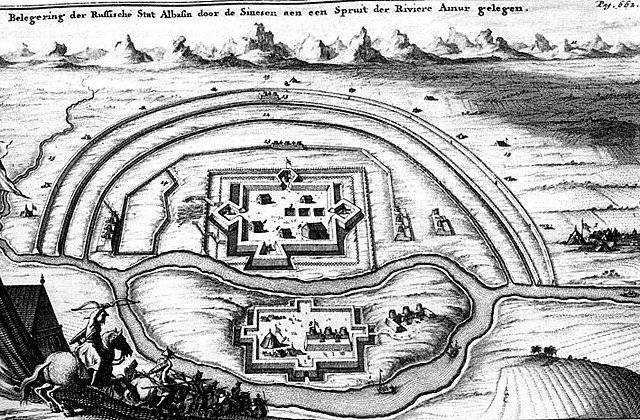
Why, after enduring the heroic siege of Albazin, in 1689 Russia gave Russia the Amur region to China
“The traveler, the message to our citizens in Lacodemont, that Sparta, having fulfilled the covenant, here we are dead bones”. These proud words are carved on a huge stone set on a hill at the entrance to the Thermopil Gorge in Greece. Here in September 480 year BC. er there was a famous battle of three hundred Spartans under the command of King Leonid with the Persian army of Xerxes. The heroes died to every single one, but provided the much-needed time to join the units of the Greek cities-policies in a single army.
The Cossacks in the Far East also have Thermopylae. This is the Albazinsky prison, whose defense in 1685 and 1686 will forever remain one of the most heroic pages in stories Russia. Like the Spartans of Leonid, the Cossacks managed, at the cost of incredible efforts and sacrifices, to keep their most important strategic milestone on Amur. And, like the Spartans, were betrayed.
"According to the Cossack painting, supposedly Kromy, erected ..."
As it was already mentioned in the article “Albazinsky siege: Cossacks against the Chinese,” immediately after returning to Albazin, ataman Alexey Tolbuzin began to restore the Albazinsky fortress with all his might. The basis of the new structure was not the old-Moscow or Siberian experience of fortification, based on the use of wooden structures, but the Cossack, Don. In the official “fairy tale” sent to Moscow, the Nerchinsky voivode Ivan Vlasov wrote: “The Albazinsky jail is done good, due to the Cossack painting, erected by Kromy, erected…” ”Sounds like a verdict of guaranteed impregnability of the new fortress: in 1685, the“ sovereign serfs ”remembered, of course, Kromy’s fortress in the Time of Troubles, which was successfully defended by Don Ataman Andrei Korela for six months.
The Cossack fortresses differed not by the height of the walls, but by the wide use for the purposes of land fortification - this feature of the Cossack fortification directly copied the experience of the ancient Roman military camps. The Cossacks dug deep ditches, the land of which was poured out on wide lattice fellings from large tree trunks, and as a result a relatively low shaft with a wide upper platform was obtained, along which even small cannons could be moved. This design of Cossack fortresses provided the ability to quickly move the available forces of the defenders (whom the Cossacks never had in abundance) to the most threatened, fraught with breakthrough assault directions. In addition, the cores were easily tied up in the ground, and the earth thrown away by the explosion of a land mine practically had no striking effect.
The new Albazinskaya fortress became, apparently, the most powerful fortification in the upper reaches of the Amur, even Aygun — the main Chinese outpost in the region — was inferior to Albazin. However, Albazin also had his “Achilles heel” - lack of artillery: in the fortress there were only eight old copper cannons and three light Zatinov squeaks, somehow “survived” in Nerchinsk since the time of Yerofey Khabarov. In the desperate bustle of preparation for the invasion, the Chinese were dragged to Albazin and a heavy mortar that fired poods. This cannon, which throws a nucleus in a high parabola, would be invaluable for the assailants, but it is completely useless for defense. Moreover, with its huge caliber, the mortar literally “ate” scarce powder.
Cossack German
The main defensive resource Albazin were, of course, people. Ordinary people - Don, Tobolsk and Trans-Baikal Cossacks - quite consciously and without any administrative coercion returned to Albazin after their courageous and resolute ataman Tolbuzin. The Batko himself did not know, it seemed tired. There was a feeling that he appeared at the same time everywhere: on the pier under construction, on the observation tower, in deep, specially dug at the base of the shafts of the powder magazine, in artillery calculations.
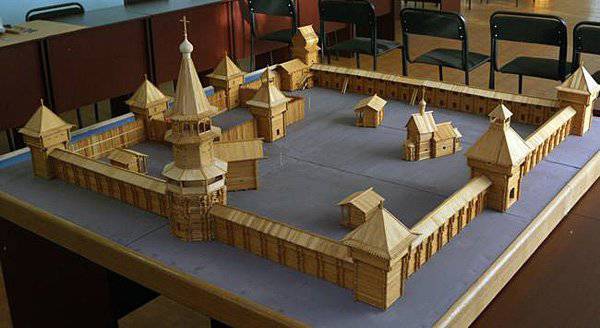
Another very valuable figure of the coming strategic battle between Muscovy and China was the German Athanasius Beyton - the brilliant military genius of Albazin. As a Prussian officer, Beyton joined the Russian army in 1654, and immediately took part in the Russian-Polish war of 1654 — 1667 that had begun. Even before its graduation, he was transferred to service in Tomsk, where, among other officers from among foreigners, he taught Great Russian raters for the emerging regiments of the “new order”.
In Tomsk, in 1665, Beyton married a Cossack and, like every German who has been living in Russia for a long time, absolutely sincerely Russified. He got into the Cossacks, accepted Orthodoxy and, for his services, was transferred to Moscow for promotion to the “boyar children”. However, in the musty half-Byzantine palaces of then-Moscow, “Cossack German” Athanasius seemed incredibly dreary, and he filed a petition about transferring to Yeniseisk - an unprecedented case for the Great-Russian nobility itself.
In Siberia, Beyton had to participate in a multitude of Cossack raids against the Dzungars and the Yenisei Kyrgyz, and in all the campaigns the German showed himself to be an excellent commander and an excellent comrade. Small in size, with a mustache dangling in Zaporozhye style, the German Beyton in the blue Cossack chekmen and shaggy fur hat did not differ in appearance from the Cossacks surrounding him. This difference was visible and audible only in battle: instead of Cossack drafts, the German preferred a heavy Prussian broadsword, and instead of a wolf howl familiar to attacking Cossacks, furiously shouted "Mein Gott!" Both of them had no personal ambition or enrichment, but military success in the fight against China.
Cossacks and Chinese: a struggle of the will
Albazin's revival took place so quickly that at the headquarters of the Aigun group of the Chinese army at first did not want to believe the evidence of the spies. Then irritation came: Cossacks were accused of treachery. The irritation of the Chinese military leaders was all the more so that the emperor Kangxi was already informed about the complete victory over the Mi-Hou [literal translation from Chinese: "people with faces that look like monkeys." - N.L.].
The hatred of the Chinese towards the Cossacks of Albazin was further increased by the fact that, unlike in previous years, the Cossacks under the command of Bayton clearly tried to intercept the military initiative. October 2 1685 of the year on the distant approaches to Albazin (on the so-called Levkayev meadow, in the area of modern Blagoveshchensk) Cossack hundred interrupted the Chinese border patrol from 27 people. In response, on October 14, the Manchurian cavalry Kangxi attacked and burned Pokrovskaya settlement, partly interrupting, and partly capturing the Russian immigrant peasants. The Cossacks of Baytona rushed in pursuit, but the Manchus managed to escape to the right bank of the Amur, which the Cossacks were prevented from crossing by the beginning of the freezing. However, in early November, on the first ice, Beyton crossed Cupid and destroyed the Chinese crossing at the place of the Manchurian village of Monastyrshchina burned. In early December, the Cossacks successfully attacked the Manchurian village of Esuli on the Chinese bank of the Amur River, burned him, and, taking the prisoners, safely left for Albazin.
In response, the Chinese made a daring raid right in the heart of Albazin: only 10 versts from the fortress, they completely burned the Russian village of Big Zaimka. This audacity ignited the Cossacks, and they decided to respond in such a way as to permanently discourage the Chinese from the desire to “make a search” for Albazin. It was decided to strike the blow directly to the strategic deployment center of the Aigun Kangxi group of troops in the Huma military camp, which served as the main base for the raids of Chinese troops up the Amur River.
Early in the morning of February 24, a regular Manchurian patrol went beyond the walls of Khum to build. The Manchus did not have time to mount their horses, when a coordinated aimed volley came from the slope of the nearest hill: eight cavalrymen were killed on the spot. Following this, from the side of the hollow, adjacent to the fortress, with a fierce wolf howl to Hume, the Cossack "special forces" rushed: foot, specially selected re-guns, armed with daggers and pistols. The Manchus tried to leave at the gates of the fortress, but it was not there: the horses, frightened by a wolfish howl, broke off their frenulums, were torn at will, and trampled down fallen horsemen. Within a few minutes, and the gates of Huma were already wide open, the plasters who had captured them. The Manchurian garrison inside the fortress tried to repel the gates, but it was too late - two hundred Cossacks of Bayton flew into them on the frosty horses. Went to chopping. It resulted in forty Manchurian corpses, a dozen prisoners and Hume to the ground. Beyton lost seven people.
New battle for Albazin
The burning of Huma shook the Emperor Kangxi's office: it became clear that a new large-scale military expedition against Albazin was indispensable. An experienced strategist Kansi decided not to hurry, but then he solved the problem once and for all: the Cossacks had to be knocked out not only from Cupid, but generally from Transbaikalia. The secret office of the emperor, having received this instruction, soon prepared a detailed military-strategic report: a kind of Chinese plan “Barbarossa”.
According to this plan, the Chinese army was to strike Albazin with all its might. At the same time, the Mongols, allied with China, were supposed to cut off all the Russian communications leading to Nerchinsk, the main Muscovite military base in Transbaikalia, acting on the eastern tip of Baikal. Then by concentric blows of the Chinese from the east, and the Mongols from the west, Nerchinsk should be captured and destroyed along with the surrounding Russian population. The strategic result of the campaign was to be a complete sweep of Transbaikalia from the Russians - the united Mongol-Chinese army, according to Kangxi’s plans, went out to Baikal, where a powerful military fort should be built.
Lantan, the commander-in-chief of the expeditionary corps, enrolled in personal submission to the emperor Kangxi, began military actions on June 11 of the year. The forces of the Chinese army were considerable: 1686 selected Manchu cavalrymen and 3000 Chinese infantrymen with 4500 guns and 40 military and cargo ships.
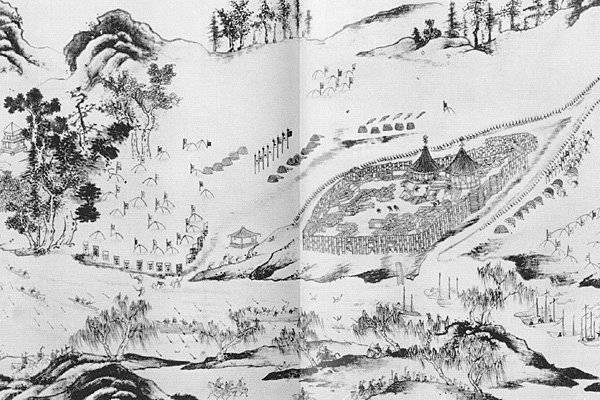
On July 9, 1686, the Chinese army approached Albazin. The Cossacks were already waiting for her: the entire Russian population of the surrounding villages was sheltered behind the walls in time, and the already spiky fields were burned down.
Slowly spreading, the army of Lantanya gradually surrounded the fortress. Chinese ships approached a new, well-cut pier. Lantan, contentedly surveying his military armada from his horse, did not suspect resistance. How later he regretted his carelessness!
The gates of Albazin suddenly swung open, and out of them, down the steep slope of the Amur shore, five hundred Cossack men armed to the teeth rushed. Their blow was terrible: the Chinese infantrymen, who had not managed to reorganize from the marching order to the siege, were crushed, panic began. Flooded from head to foot by a stranger and with their blood, tirelessly smashing daggers of a distraught enemy, the Cossacks stubbornly broke through to the shore - where Chinese ships were moored to weapons and provisions. Another onslaught, and they broke into the pier - the nearby Chinese ships flamed - just those that had food for the Chinese army. It seemed that the defeat of the army of Lantanya was close: only one blow of three or four hundred Cossacks to the flank of the actually overturned Chinese army could solve the whole matter. Alas, there was not even a single reserve of hundreds — hello to Muscovy courtiers — the governor of Tolbuzin did not have: the decades of incompetent resettlement policies once again fully demonstrated their fruits.
The flank strike of the Cossacks could not have happened, but Manchurian cavalrymen, who had reached the battle site in time, were able to inflict it. To the credit of the Cossack German Bayton, he was waiting for this blow: a quickly rebuilt flanking hundred struck the Manchus and provided a complete order for the Cossacks to retreat to the fortress.
Lantan was terribly annoyed by what had happened, moreover, the problem of providing the army with food was immediately confronting him. In a rage, the commander Kansi ordered the execution of the commanders of those Chinese formations who had fled. However, in the future, the practice of the “punishing sword” had to be abandoned: July 13 Beyton repeated the sortie from Albazin with almost the same result: the Chinese again ran, the Manchus with a flank blow again managed to stop the advancing Cossacks. The main weakness of Albazin became clear to Lantanu: the lack of the necessary number of defenders. Realizing this, the commander Kangxi proceeded to the methodical siege of the fortress.
Pale Death Challenge
Initially, the Chinese commander ordered a massive bombardment of the fortress from all the barreled "artillery artillery". There was a lot of shooting, but the fortress, built on the Cossack technology, withstood all the shelling. True, after two months of systematic attacks, the garrison of Albazin suffered a really heavy loss: on September 13, the Chinese core tore off the leg above the knee of Governor Alexei Tolbuzin. From the painful shock and great blood loss, the Tobolsk ataman died four days later. "Cossack German" Beyton was very sad about the loss of a friend. Later, he will sincerely write in his report: "We drank one bloody cup with the deceased, with Alexey Larionovich, and he chose heavenly joy for himself, and left us in sorrow."
Enough to get around Albazin, Lantan in 20 in September 1686 decided to persuade the garrison to surrender. The command of the fortress with the dismissed Russian prisoner Fedorov was given a letter: “You are not angry with big forces, rather surrender ... And if it doesn’t happen, you won’t disperse with anything good”. Beyton answered with a firm refusal and, with mockery, he released three Manchu prisoners outside the walls of the fortress: they say, for one Russian I give three of your “gods”.
Lantan took the hint and immediately left the troops to assault Albazin. The assault was continuous by all the forces of the Chinese army for five days (!) And did not give the attackers any results. Then, before the beginning of October, commander Kansi still twice raised his troops to storm the Cossack Thermopylae - and again without result. Moreover, in response to the assaults, the Cossacks went over to the raids. As a result, the most productive of them, the fifth in a row, were detonated artillery depots and the food grain delivered from the lower reaches of the Amur River again burned.
As a result, by the middle of October the position of the expeditionary army of Lantanya was very complicated. Only irretrievable losses in manpower were more than 1500 people, ammunition was running out, the food ration per soldier was reduced four times. The resistance of the Cossacks in Albazin was so overwhelmingly effective that the personal office of the emperor Kangxi was forced to issue a special circular for foreign ambassadors explaining the setbacks on Amur. The “explanation” was made, of course, taking into account the Chinese mentality: “The Russians who are in Albazin stand to death, since they have no choice. All of them are convicted criminals who are not able to return to their homeland. ”
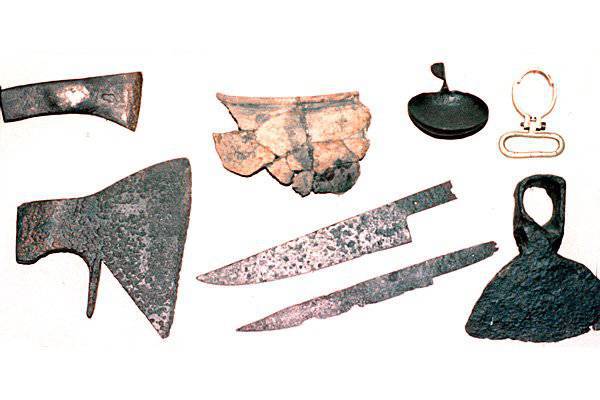
In early November, 1686, Lantan ordered the cessation of all active operations against Albazin and the beginning of a “deaf” siege. The Chinese commander would not have made, perhaps, this is a rash decision if he knew that only the 826 people had survived from the defenders of the fortress, and the entire central area of the fortress had been turned into a cemetery. In Albazin, scurvy was rampant - all the main losses of the Cossacks were not from the bullets of the Chinese, but from the "pale death" and related diseases. Beyton himself, due to swollen ulcerated legs, could hardly walk on crutches.
However, the situation in the Chinese military camp was slightly better. Already in December, as a result of Cossack raids, Lantan almost ran out of food - the Chinese army began to resemble a crowd of thinning people who could hardly hold weapons. Lantan also could not retreat from Albazin: the Chinese court flotilla frozen into Amur, and the Manchu horses were either eaten or fell from lack of fodder. In severe frosts, the walking march of extremely exhausted people, more than 500 km long, to Fort Esuli burnt by Cossacks could become a death sentence for the entire Chinese army.
In the current situation, if the Muscovite administration in Transbaikalia had at least some kind of available military forces, one strike by a military detachment in 200 — 300 would be enough to put an end to all the Chinese expeditionary force once and for all.
Military results Cossack Thermopil
Information about the military embarrassment of the Chinese expeditionary army in the Amur region became, finally, the property of the diplomatic circles of the countries of Asia and Europe. In order to preserve political prestige, the Qing Empire refused to withdraw its troops from Cupid, although the epidemic covered the epidemic with exhausted soldiers: in January-February 1687, the Chinese only lost more than a thousand soldiers from illness. Nevertheless, Lantan, not having received the order to retreat, clasped his teeth, continued the “deaf” siege of Albazin. However, at the beginning of 1687, the Cossack fortress was defended, probably, not by people, but by the unbroken spirit of the heroes who died here: only 66 defenders remained in Albazin, of whom only nineteen Cossacks could hold a weapon.
The order to completely lift the siege of Lantagne received only at the beginning of May 1687. A nasty crowd of human shadows, in which fierce Manchu warriors could hardly be recognized, slowly stretched down the Amur. Far from Albazin, this host could not depart: after ten miles the Chinese set up a camp in which the Kangxi soldiers would clean up until the end of August. Only on August 30, the pitiful remnants of the Lantanya Corps set sail on ships towards Aigun. The invasion ended in failure.
As a result, the Albazin Thermopylae influence of the Empire of the Qing in the Amur basin became elusive. Success at Albazin was not the only one. The Cossacks of the Yakut Voivodeship severely suppressed the Tungus uprising, inspired by the Chinese emissaries. Pursuing the Tungus, the Cossacks found a large Chinese squad in the Tungirskiy portage area and completely destroyed it. The Cossacks of Nerchinsk utterly routed the Munghal khans, allies of Kangxi. Having lost several thousand horsemen, the mungals (Mongols) unconditionally emerged from the war, and now there could be no talk of any concentric attack on Nerchinsk from both sides. In Yeniseisk, a four-thousandth Cossack-Russian army was prepared for shipment to Amur. It seemed that Moscow Russia had forever become the possession of the richest lands along the Amur. Alas, it just seemed ...
Heavy negotiations
20 July 1689, the Russian-Chinese peace negotiations began in Nerchinsk. From the side of the Muscovites they were led by Fyodor Golovin - later a prominent figure in the “nest of Petrov”. Golovin was a typical representative of the Moscow elite of pre-Peter the Great, the era of the breakdown of Great Russian national identity as a result of the destructive reforms of Patriarch Nikon. Of a sharp mind, but unprincipled, monstrously quirky, but strong-willed, Fyodor Golovin could easily “walk over the head” for his personal career if he could successfully realize his diplomatic mission in Nerchinsk if the ax of an unconditional royal will hung over him. Alas, they did not feel this will in Nerchinsk: the final act of struggle between Tsarina Sofia Alekseevna and young Peter I for power unfolded in Moscow. Golovin was granted, in essence, to himself and, with clear benefit for himself, ordered this provision.
From the Chinese side, the diplomatic mission was headed by the commander of the Emperor's Guard, Prince Songgotu. The delegation included Lantan, already known to us, as well as two Jesuit translators: the Spaniard Thomas Pereira and the Frenchman Jean-François Gerbillon.
Negotiations were not easy. The main stumbling block was, of course, Albazin. The Chinese demanded the unconditional destruction of these Cossack Thermopylae. Fyodor Golovin was ready to recognize China’s sovereignty over the lower reaches of the Amur, but on condition that the border between Russia and China along Albazin was maintained. The instruction received by Golovin in the Ambassadorial Order of Muscovy clearly demanded the preservation of Albazin as an eastern military outpost of Russia. There was a time when Prince Songotu tried to "turn the chessboard": he began to threaten immediate war, - the good ambassadors arrived in Nerchinsk, accompanied by troops in 15 thousands of people and a special artillery regiment. Golovin, who did not bother to advance the military forces to Nerchinsk, could rely only on the consolidated corps of Russian archers, Cossacks and Tunguses, with a total number of not more than three thousand people. Nevertheless, in this case, Golovin showed determination: he announced to Songhotot his agreement to interrupt the negotiations and began to demonstratively strengthen the walls of Nerchinsk.
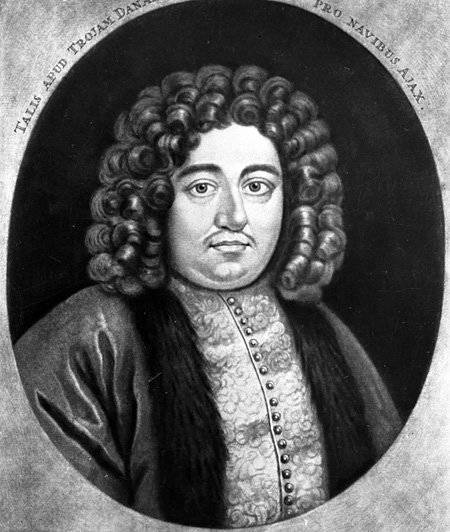
Songhotu, seeing the Russians' determination to fight, returned to the negotiations. The Chinese prince couldn’t do otherwise simply, because on the eve he received a clear instruction from the emperor himself, where Kangxi ordered to substantially moderate territorial claims against the Russians. “If Nerchinsk is made the border, then the Russian envoys,” Kansi wrote, “will have no place to stop, and this will make communication difficult ... You can make Aigun the border.”
The Chinese fort Aygun was located more than 500 km east of Albazin, which means that the Chinese were not only willing to accept the existence of Albazin, but even to transfer the Muscovites a huge strip of land east of the fortress.
Such flexibility of Kansi was, of course, not accidental. Albazin was not taken, the walls of the fortress were strengthened. On the Mongolian-Chinese border, it became very restless: yesterday's allies were clearly preparing for war with China. However, the most disturbing event was the powerful invasion of the Jungars in the western provinces of Qing. The Supreme Khan of the Dzungars, Galdan, insistently offered Moscow Rus a joint military intervention in China. Kansi had no illusions about whether Fedor Golovin knows about these initiatives of the Dzungar Khan. Golovin, of course, knew about it. He knew ... - and passed Albazin!
Betrayed and forgotten
How this happened is still not clear to any historian in the world. How was it possible to agree to the total destruction of a fortress not occupied by the enemy, while donating to him over 1 million square kilometers? With the painting of Fyodor Golovin on the Nerchinsky Treaty, Moscow Russia lost practically the entire Amur basin, conquered by the Cossacks, down to the Pacific coast. The strategic heights of the Greater and Lesser Khingan were lost. And with the loss of the fertile lands of the Middle Amur plains, Russia automatically lost grain (that is, food) self-sufficiency of Transbaikalia and Eastern Siberia. Now every kilogram of grain needed to be transported to Nerchinsk or Yakutsk not from a distance of 700 — 800 km, but from the Urals and Western Siberia, that is, thousands of kilometers to the distance 3,5 — 4!
When Fyodor Golovin returned to Moscow, he did not try to explain to Tsar Peter I how it was possible in extremely favorable foreign policy conditions to lose at the negotiating table what was reliably protected by Cossack tenacity in bloody struggle. The complete liquidation of the large gold treasury, which was issued to him in the Ambassadorial order for the needs of bribing foreign ambassadors, as well as "ingorious thieves and lovely people," Golovin explained by the need ... of bribing Jesuit translators. Only thanks to this generous bribe, damned Catholics agreed to help Muscovite, finally, to resist, stubborn, absolutely inflexible "Bogdoytsev."
The famous Russian proverb that, if not caught, means not a thief, was born, undoubtedly, in the gloomy corridors of Muscovy orders. Fedor Golovin was not caught by the hand. The first of the great Russian boyars cut off his beard and lit a smelly pipe, he made a brilliant career under Peter I. To whom a bribe was brought for the surrender and destruction of Albazin — Golovin or, nevertheless, the mission of the Jesuits, Songgotu — would remain a secret for ever. However, common sense cannot remain outside the boundaries of time: why did it have to pay when, according to the instructions of the emperor Kangxi, the mission of Songgotu was to transfer to the possession of Russia not only Albazin, but practically all of the average Amur ?!
There is an old Cossack legend about how Esaul Beyton said goodbye to Albazin. Having received the monstrous order of Fyodor Golovin, which ordered "... the city of Albazin to be ruined and the shaft unearthed, and service people with their wives and children and with all their stomachs brought to Nerchinsk", Beyton gathered Cossacks on the bank of the Amur. He persuaded them for a long time that it was necessary to leave, that the real forces from Muscovy did not come for all the time after the siege, that the Chinese would still come back and would again be cutting, there would be blood. The Cossacks argued stubbornly, refused to leave. Then, in a rage, Beyton snatched his heavy sword from the scabbard and with the words: “Do not happen to us in Albazin - how can this broadsword not emerge!” - threw his weapon at Amur. And here, wow! The broadsword, supported by a powerful whirlpool, suddenly floated upwards with a handle - as if in the form of a cross - and, glittering with a gilded stripe in the sun, slowly, very slowly went to the bottom ...
After the departure of the Cossacks from Albazin, the Russian people were able to re-enter the high banks of the Amur only two hundred years later - in the second half of the 19th century.
In Fermopilsky gorge already after 60 years after the death of three hundred Spartans, a stern, beautiful in its manly simplicity monument was erected. In the small village of Albazino in the Amur Region, which is just as slowly fading away as thousands of other villages in Russia, there is still no monument to the fallen Cossacks.
Information